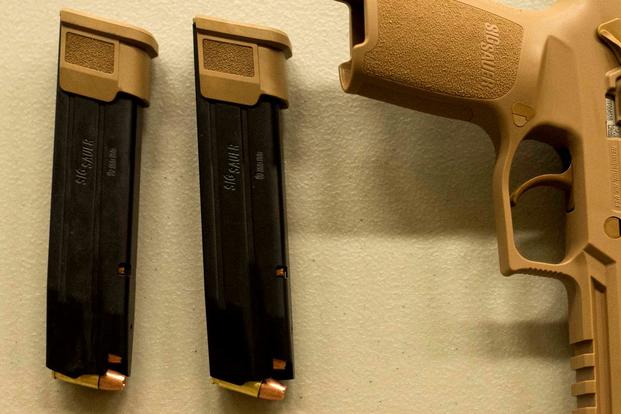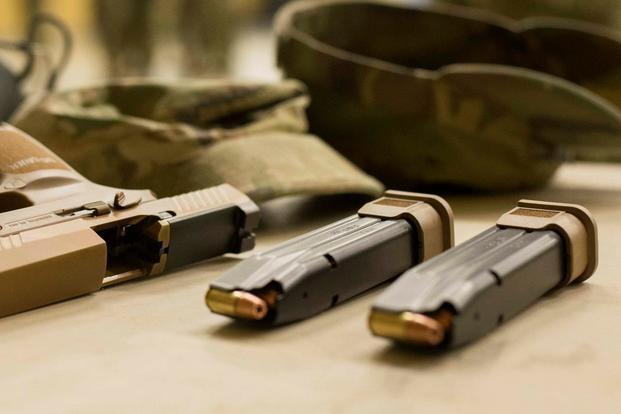The U.S. Army has begun fielding its new sidearm that will replace the M9 pistol, but weapons officials remain tight-lipped about the new ammunition that promises to make the Modular Handgun System more lethal than its Cold War predecessor.
One of the major goals of the MHS effort is to adopt a pistol chambered for a more potent round than the current 9mm.
During the summer of 2015, Army officials revealed that a new Defense Department policy would allow the service to use "special-purpose ammunition" for the MHS program, a significant break from its past devotion to ball ammunition.
In January, the Army selected Sig Sauer to produce the XM17 full-size MHS and the XM18 compact MHS. Sig Sauer partnered with Winchester to provide the ammunition.
Related content:
- Army Unveils Holster for Modular Handgun System
- Army Explains New Dual-Arming Policy for Modular Handgun System
- US Army to Field New Sidearm Down to Team Leader Level
Winchester is the largest commercial supplier of small-caliber ammunition to the U.S. military, company officials maintain. The firm has been supplying the M882 9mm ball round to the military for more than 30 years, according to Winchester officials.
The new Winchester XM1153 is a 147-grain jacketed hollow point bullet and "currently the principal go-to-war ammunition" for MHS, Lt. Col. Steven Power, head of Product Manager Individual Weapons, told defense reporters at a recent round-table discussion.
The Nov. 30 press event came two days after soldiers from the 101st Airborne Division (Air Assault) at Fort Campbell, Kentucky, became the first Army unit to receive the MHS.
Winchester officials maintain that its XM1153 is "about 25 percent better than the M882 [ball] round from a lethality standpoint."
Beyond that, weapons officials remain reluctant to describe in detail how they quantify that performance percentage increase or how the Winchester round was selected over other projectiles tested in the competition, which included calibers larger than 9mm, such as .40 caliber.
"When you talk about capability in systems that protect our soldiers, we just as a matter of policy try not to talk about that because it can be useful to adversaries," Power said, adding that ballistic gelatin testing was one of the types of testing used to measure the size of the wound cavity left by the bullet.
Army officials would not talk about the composition of the round or the types of barriers it is designed to penetrate -- a sharp contrast to the unveiling of the service's M855A1 Enhanced Performance Round
The Army replaced the Cold War-era M855 5.56mm round in 2010 with the new M855A1 EPR, the result of more than a decade of work to develop a lead-free round.
Army officials were very open about the M855A1 and invited reporters out to a range to show off the performance of the new round, which features a steel penetrator on top of a solid copper slug, making it is more dependable than the current M855, Army officials have said.
The M855A1 delivers consistent performance at all distances and penetrates 3/8-inch-thick steel at ranges approaching 400 meters, tripling the performance of the M855, Army officials say.
But at the Nov. 30 MHS event, Army weapons officials said the M855A1 was an Army-led engineering change proposal. By contrast, the Winchester XM1153 9mm jacketed hollow point round was chosen under "source selection," which prevents the service from discussing it in detail.
"This was a source selection event so because it is source selection sensitive, we can't share all of the information that was gathered there," according to Daryl Eastlick, deputy of the Lethality Branch at the Maneuver Center of Excellence at Fort Benning, Georgia.
The testing involved Army Research, Engineering and Development Command and Army Research Laboratory, Eastlick said.
"They both worked together during the source selection process to give us the technical information we needed to understand what that lethality was," he said.
"They did that through a very rigorous process that includes shooting ballistic gelatin and using modeling and simulation to understand what it would do on different shot lines and how it performs actually in reality."
Weapons officials say they will likely be less transparent about capability specifics in the future.
"Some of the programs we are moving forward with -- that kind of started with MHS but more so with others -- you are going to kind of see us being less transparent when it comes to our capability," Power said.
-- Matthew Cox can be reached at matthew.cox@military.com.











